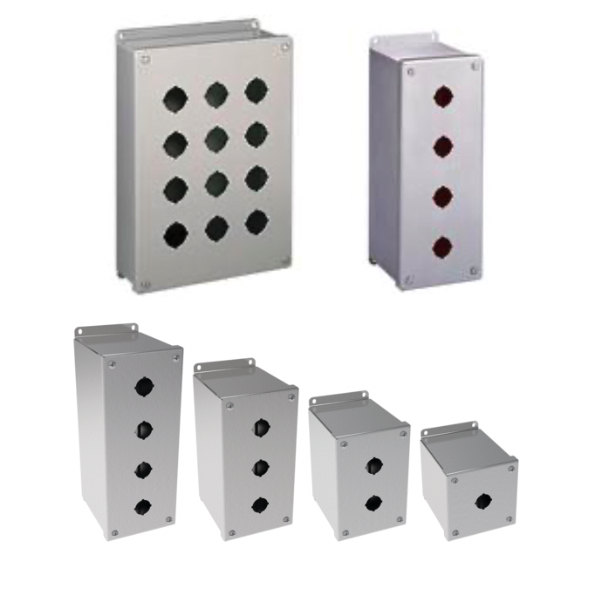Stainless Steel Push Button Enclosures

Stainless steel push button enclosures are meant to supply sturdy protection for switches, pilot lights, and other industrial control devices. They're made from 304 stainless steel and are built to prevent dust, dirt, and water; against oil and other harmful agents you find in industrial environments from damaging the components. Their construction helps make sure that what you want to have working indoors or outdoors is going to keep on working, both because of the way they are built and because of the materials used to build them. These are NEMA Type 4, 4X, and 12 enclosures, which means that with these stainless steel enclosures, you're getting excellent protection from a variety of harsh conditions.
These enclosures can take on a variety of forms, with some models containing factory-drilled holes for standard push-button devices (which measure 30.5 mm across). They are well-suited to holding switches and pilot lights, with all such devices remaining happily accessible and with their wiring secure. The stainless steel from which they're made lends them a durability such that you can expect them to last as long as any working device you install in them.
More Information about Stainless Steel Push Button Enclosures
For industries such as manufacturing, oil and gas, and food processing, where durability and protection are of utmost importance, stainless steel pushbutton enclosures are the favored option. These enclosures are designed to not only meet but also exceed rigorous engineering standards, providing incredibly robust and reliable performance. And yet, despite their toughness, they look good too, which makes them a nice addition to any workspace. But what really makes these enclosures the go-to solution for so many industrial applications is their wide array of sizes and configurations—they are incredibly versatile as well as dependable.
FAQs
Can stainless steel pushbutton enclosures be designed with sealed wells and seams as well as a door for easy access?
Yes, stainless steel pushbutton enclosures can be designed with sealed wells and seams for protection as well as a door for easy access to internal components.
Stainless Steel Enclosures: Type 304 vs 316
304 Stainless Steel
304 stainless steel contains 18% chromium and 8% nickel. It is the most widely used stainless steel within industrial applications. 304 stainless steel resists corrosion and oxidizing agents, which can cause rusting. However, it can tarnish. 304 stainless steel is very strong and can be bent without decreasing the strength, but it can be difficult to manipulate. Because of its corrosive resistance, 304 stainless steel enclosures are commonly used in dairy plants, mills, bakeries, and many other food processing industries.
316 Stainless Steel
316 stainless steel This is a much higher grade of stainless steel containing 16% chromium, 10% nickel and 2% molybdenum, which significantly increases its resistance to pitting and cracking. It has increased corrosive resistance to chloride pollutants, such as salt. 316 stainless steel enclosures are ideal for areas there may have a high salt content, such as coastal areas and areas that use de-icing salts. This type of stainless steel is much more resistant to chemical environments that include sulphuric acid, phosphoric acid or many other chemicals. These types of stainless steel enclosures can be found in areas with high levels of corrosive agents, such as water, wastewater, chemical plants and fertilizer plants. Both 304 and 316 stainless steel enclosures are NEMA 4X rated due to their corrosion resistance, however it is important to remember to never use any chemicals that contain chlorine.

